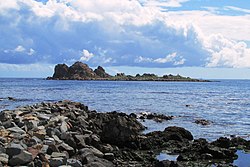Coquimbo (region)
|
Coquimbo IV Región - Chile IV Región de Coquimbo |
|||
|---|---|---|---|
| Region of Chile | |||
 |
|||
|
|||
 Map of Coquimbo IV Región - Chile |
|||
| Coordinates: 29°54′28″S 70°15′15″W / 29.90778°S 70.25417°WCoordinates: 29°54′28″S 70°15′15″W / 29.90778°S 70.25417°W | |||
| Country |
|
||
| Capital | La Serena | ||
| Provinces | Elqui, Limarí, Choapa | ||
| Government | |||
| • Intendant | Claudio Ibáñez | ||
| Area | |||
| • Total | 40,579.9 km2 (15,668.0 sq mi) | ||
| Area rank | 7 | ||
| Lowest elevation | 0 m (0 ft) | ||
| Population (2012 census) | |||
| • Total | 687,806 | ||
| • Rank | 8 | ||
| • Density | 17/km2 (44/sq mi) | ||
| ISO 3166 code | CL-CO | ||
| Website | Official website (in Spanish) | ||
The IV Coquimbo Region (Spanish: IV Región de Coquimbo pronounced [koˈkimbo]) is one of Chile's 15 first order administrative divisions. It is some 400 km north of the capital, Santiago.
The capital and largest city is La Serena, other important cities include the seaport Coquimbo and the agricultural centre Ovalle.
The Coquimbo Region forms the narrowest part, or 'waist' of Chile, and is hence one of the country's more mountainous regions, as the Andes range runs closer to the sea than elsewhere. The region has notable marine species as well as taxa that are associated with the mountainous regions. With respect to marine organisms, the upwelling areas encourage bioproductivity off of this Pacific Coast area of Chile.
In the southern mountainous areas of the Coquimbo Region, the rare and endangered Chilean Wine Palm is found, whose habitat is threatened by human overpopulation in the region and associated deforestation for residential expansion and agriculture.
The Elqui Valley is home to a number of astronomical observatories, owing to the region's clear skies. It is also home to a 600-meter-long dam, the Puclaro, which confines the Elqui River and produces a reservoir of some seven km in length.
Mining and agricultural activities account for the location of various places in the region, around the transverse valleys and mineral deposits. Originally this organization was structured according to the location of Indian villages of the Diaguitas. A high percentage (70-75%) of inhabitants are of Mestizo (Euro-Amerindian) background, higher than any other region in Chile. Other indigenous peoples include the Aymara, Atacameno, Mapuche and Quechua whom were immigrants themselves from Peru and Bolivia.
...
Wikipedia


